Rubies and Sapphires from Snezhnoe, Tajikistan
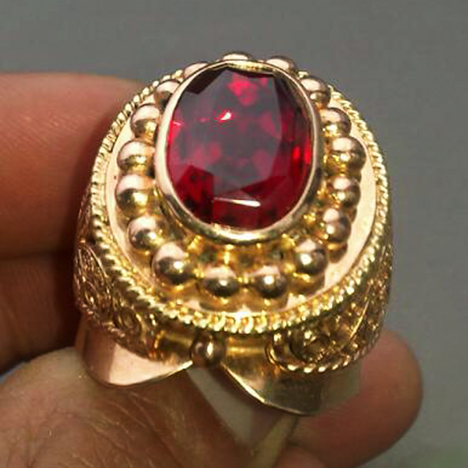
ABSTRACT
Discovered during the late 1970s, the Snezhnoe ruby and sapphire deposit in Tajikistan was active until the collapse of the former Soviet Union in the early 1990s and the outbreak of regional conflicts. This marble-hosted occurrence has seen renewed interest, as it is a large and potentially productive deposit that has not been sufficiently studied. Testing of samples identified solid inclusions of margarite enriched with Na and Li (calcic ephesite or soda margarite). These are believed to be previously unreported for gem corundum. Allanite, muscovite, and fuchsite (chromium-bearing muscovite) were identified for the first time in ruby and sapphire from Snezhnoe. These and other inclusions such as zircon, rutile, K-feldspar, and Ca-Na-plagioclase could serve to distinguish them from stones mined elsewhere. Concentrations of trace elements were typical for ruby and sapphire of the same formation type. The highest Cr concentrations were observed within the bright red marble-hosted rubies, and these values were very similar to those of the famous Burmese rubies from Mogok.
INTRODUCTION
Corundum—α-Al2O3—is a common, though minor, component of many metamorphic rocks. Gem-quality varieties of ruby and sapphire occur in only a few primary metamorphic and magmatic rock types depleted in silica and enriched in alumina (Giuliani et al., 2007) and in the secondary placers formed by the erosion of these rocks (e.g., Hughes, 1997; Kievlenko, 2003).
The traditional supplier of ruby and sapphire to the world markets is Southeast Asia. Burmese rubies from the Mogok deposit have historically held the highest value, stemming from their “pigeon’s blood” color, a bright red with a slightly purple hue (Hughes, 1997; Smith, 1998). The supply situation has changed dramatically in recent years, with the discovery of new deposits in East Africa and the continued mining of the Central and Southeast Asian occurrences.
Situated within the Pamir Mountains, Tajikistan produces a variety of gemstones, including ruby (figures 1 and 2), sapphire, spinel, aquamarine, chrysoberyl, tourmaline, topaz, clinohumite, garnet, scapolite, lazurite, and variscite (Litvinenko and Barnov, 2010). The occurrence of ruby in the Pamirs was first suggested by the Soviet mineralogist and geochemist A.E. Fersman in the early 1930s (Popov, 1936). Fersman predicted the location of ruby deposits in the Precambrian metamorphic rocks of the southwestern Pamirs, where the geological conditions are similar to those in Myanmar and Sri Lanka. This hypothesis was confirmed by Ya. A. Gurevich, I.M. Derzhavets, and colleagues during a prospecting expedition to the Pamirs in 1965, when they found a group of ruby and sapphire deposits on the western slope of the Ishkashim ridge (Litvinenko and Barnov, 2010).
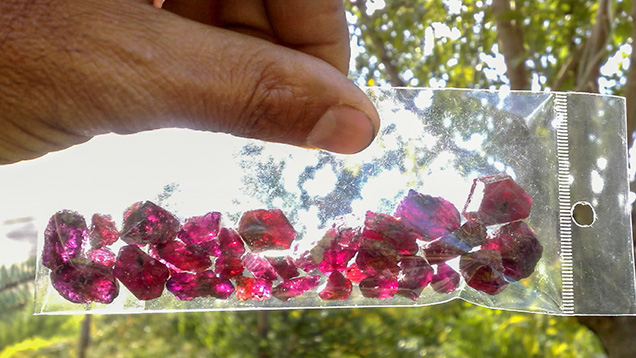
Marble-hosted ruby deposits were first detected in the Shakhdarin series (Archean age) in 1979 (Konovalenko and Rossovsky, 1980). The subsequent discovery of a new gem deposit structure—a ruby belt on the eastern part of the Central Pamirs—became something of a sensation in the 1980s (Litvinenko and Barnov, 2010). More than 50 marble-hosted ruby occurrences confined to the gneiss-marble suite of the Muzkol metamorphic complex (Paleoproterozoic) have been found within this zone. The largest of these are Snezhnoe and Trika, discovered in 1980, and Nadezhda, which followed a decade later (Litvinenko and Barnov, 2010). After the collapse of the Soviet Union, all mining and prospecting activity at these deposits was suspended for more than 15 years. Today, production figures are kept confidential by the Tajik government. Regional conflicts, combined with difficult access and climate conditions, have complicated further study of these gem deposits, though a period of stability allowed foreign researchers to visit them in the early 21st century (Bowersox, 2005; Hughes et al., 2006).
Petrographic, mineralogical, and gemological research has been conducted at various times, both by Soviet and then Russian scientists (Dmitriev, 1983; Dmitriev and Ishan-Sho, 1987; Dufour et al., 2007) and their foreign counterparts (Henn and Bank, 1990; Smith, 1998). For this article, we have updated knowledge about the geology of the Snezhnoe deposit and separated various types of ruby and sapphire crystals according to their morphology, gemological properties (including reflectance and luminescence spectra), trace-element composition, and previously unreported solid inclusions.
REGIONAL GEOLOGY
The Snezhnoe deposit is confined to the Kukurt anticlinal fold belonging to the south wing of the Shatput anticline (Kievlenko, 2003) within the eastern part of the Muzkol–Rangkul anticlinorium (outcrop of the Precambrian crystalline basement by Rossovsky, 1987; figure 3). The core of the Kukurt fold is characterized by the development of granite-gneiss in the Zarbuluk complex (possibly Proterozoic, age not determined) surrounded by gneisses and schist (Belautin suite), calcite and dolomite marbles (Sarydzhilgin suite), and quartzites and quartz sandstones (Buruluk suite) of the Muzkol metamorphic complex (Paleoproterozoic). A massif composed of leucocratic granites from the Shatpur intrusive complex (Cretaceous-Paleogene) is adjacent to the eastern part of the fold. The southern part of the fold is cut by the Muzkol regional fault, separating the Precambrian formations from Paleozoic–Mesozoic sedimentary rocks (figure 4).
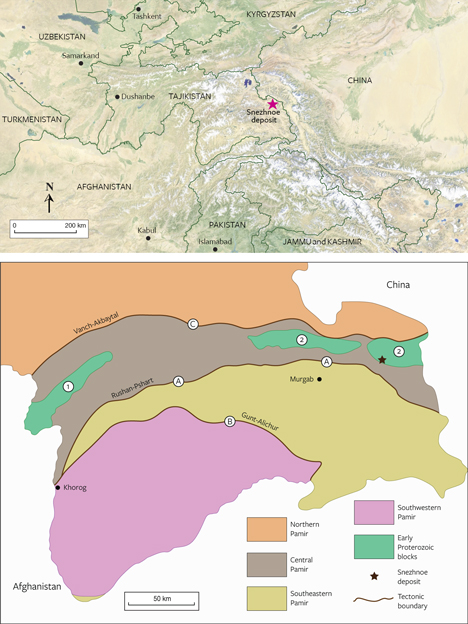
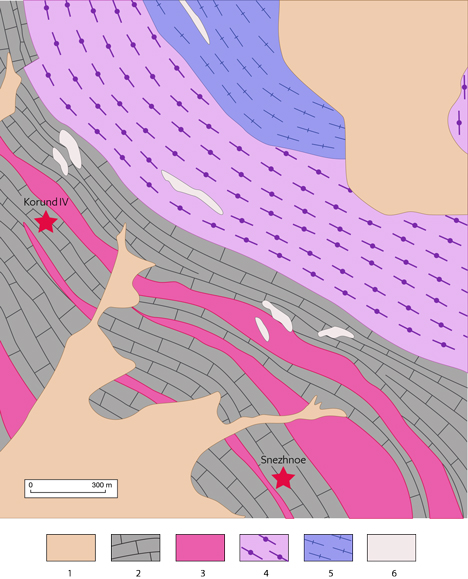
The ruby-hosted Sarydzhilgin suite, along with other suites of the Muzkol metamorphic complex (total thickness exceeding 6 km), underwent at least two tectonic metamorphic cycles. The first took place 1.8–1.6 billion years ago (Budanova, 1991) at amphibolite facies (temperature and pressure approximately 700°C and 8 kbar), and the second cycle occurred 100–20 million years ago (Budanova, 1993). This is a zonal metamorphism migrating from greenschist facies at 350ºC and 4 kbar through epidote-amphibolite facies up to 800ºC and 9 kbar (complete melting zone) (Sorokina et al., 2014). There are several theories concerning the geological age of ruby and sapphire crystals in marble, and some researchers believe that formation took place during modern alpine regional metamorphism (Dmitriev and Ishan-Sho, 1987; Dufour et al., 2007).
LOCAL GEOLOGY AND MINERAL ASSEMBLAGE
The Snezhnoe deposit is located in the eastern part of the Pamir Mountains in Tajikistan. The occurrence is situated 30 km northeast of Murgab and about 20 km south of Rangkul, a pair of villages near the Chinese border. It is on the eastern bank of the Aksu River, at an altitude more than 4,000 meters above sea level. The region containing the corundum deposits lies along the Kukurt pegmatite belt, which is enriched with gem scapolite. Ruby and pink sapphire have been found in the formation of coarse-grained calcite marbles from the Sarydzhilgin suite of the Muzkol metamorphic series (Paleoproterozoic), with a total thickness of about 20 m (figure 5). This formation lies between layers of kyanite-garnet-biotite schist and marbles.
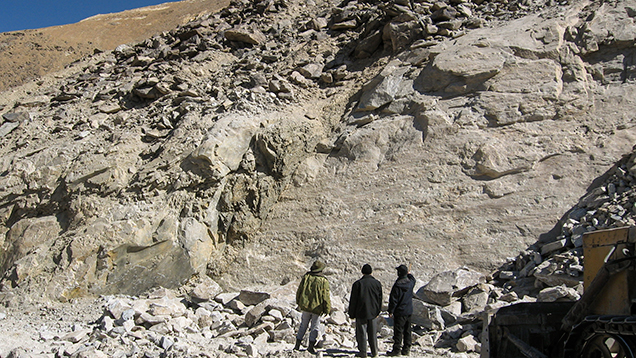
Two ruby-mineralized zones are arranged en echelon (in closely spaced, parallel, or subparallel step-like planes) in coarse-grained calcite marble parallel to their bedding planes. They can be traced along the strike for 150 to 200 m. The mineralized zones are represented by micaceous lenses (2–15 m in length, with maximum thickness of 1 m) and ruby-bearing marbles contacting with these lenses (figure 6).
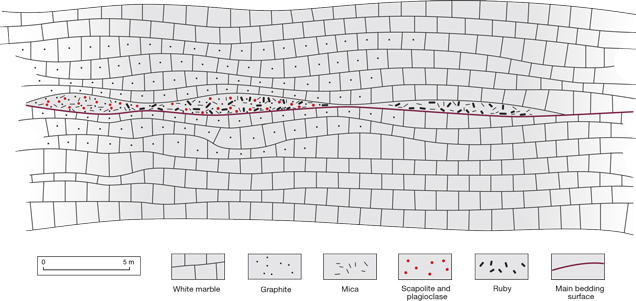
Minerals found in micaceous lenses in Snezhnoe include various types of mica (fuchsite and phlogopite), plagioclase (from albite to anorthite), and scapolite (40–60% meionite), as well as ruby and sapphire, rutile, goethite, carbonates (calcite and dolomite), minerals of the chlorite group, graphite, K-feldspar, and kaolinite (Sorokina, 2011; Sorokina et al., 2012; figure 7). Furthermore, there are marbles that consist mainly of calcite (up to 90%), ruby, mica (phlogopite and fuchsite), goethite, scapolite (about 60% meionite), plagioclase (albite to oligoclase), and graphite. Other researchers have reported amphibole (Rossovsky, 1987), pyrite, and dravite (Kievlenko, 2003).
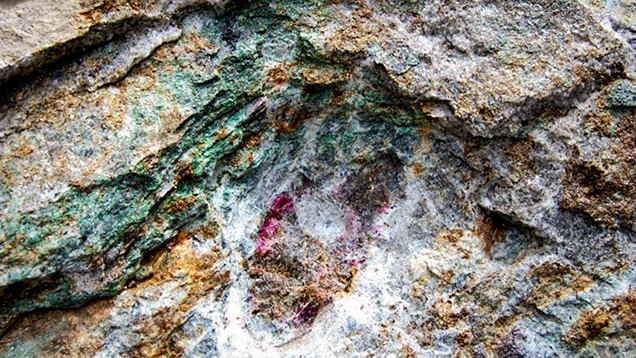
Soviet-era estimates of the Snezhnoe deposit indicated possible reserves of many hundred thousand carats of gem corundum. The authors of the present article visited the occurrence in 1982, 1986, 2008, 2009, 2012, and 2013. It is currently being worked to a depth of 30 m by the state-run Chamast enterprise, which is conducting underground mining with drilling tools and large trucks.
MATERIALS AND METHODS
The authors borrowed 41 ruby-bearing rock samples from Snezhnoe from the collection of the Fedorovsky All-Russian Research Institute of Mineral Resources (FGUP VIMS), which obtained them in the early 1980s. Two additional samples of ruby in marble from this deposit were loaned by the Vernadsky Geological Museum of Russian Academy of Science, courtesy of former chief curator Dr. Mikhail N. Kandinov.
To prepare the sample wafers, the authors cut a section of rock containing ruby and sapphire crystals. The surrounding matrix was either dissolved by 10% HCl acid or mechanically removed, or a combination of the two. Standard gemological properties were recorded, including hydrostatic SG, color, and refractive index. We performed long-wave (365 nm) and short-wave (254 nm) photoluminescence spectroscopy and observed microscopic features using an MBS-10 binocular microscope. To obtain reflectance spectra in the visible range (380–800 nm), we used a Leica-Leitz MPV-SP spectrometer with a reflection probe and a resolution of 1 nm and an integration time of 500 ms. Photoluminescence spectroscopy was performed at FGUP VIMS using a MSFU-K (LOMO) microspectrophotometer with an LGI-505 nitrogen laser (337.1 nm wavelength emission), a CAMAC registration system, an IRIS-3m generator, and an MDR-23 monochromator connected to a computer.
Laser ablation–inductively coupled plasma–mass spectrometry (LA-ICP-MS) was carried out at Johannes Gutenberg University in Mainz, Germany, with an ESI/NWR-193 laser system (193 nm) coupled to an Agilent 7500ce quadrupole ICP-MS with helium as the carrier gas. The laser spots had a diameter of 50 µm on the samples and 100 µm on the reference standards. Analyses were carried out at an energy density of 2.02 J/cm–2 with a 10 Hz repetition rate, using NIST SRM 612 glass as an external standard and NIST SRM 610 as an unknown for quality control. 27Al, measured as Al2O3 by electron microprobe, was used as the internal standard for rubies. 29Si, based on SiO2 from electron microprobe data, was used for micas. Data reduction was carried out with Glitter commercial software. Detection limits were typically in the lower parts-per-billion range, and analytical uncertainties were generally between 5% and 15%, based on the external reproducibility of the reference materials (Jacob, 2006). Microprobe analysis was carried out at the Fersman Mineralogical Museum of the Russian Academy of Sciences. For these analyses, we used a Link ISIS energy-dispersive spectrometer (EDS) electronic probe microanalyzer attached to a CamScan D4 scanning electron microscope.
DESCRIPTION OF THE ROUGH
Rough ruby and sapphire samples from the Snezhnoe deposit were found in different parts of mineralized zones and had a distinct appearance. Ruby and sapphire crystals within micaceous lenses were normally translucent—the intergrowth of transparent and translucent areas could be observed in some crystals—and displayed visible morphological defects, such as polysynthetic twinning and parting parallel to the c, a, and r corundum faces. As a result, they were usually unsuitable for faceting or even cabochons. Their morphology and color varied from purple elongated prisms to slightly pink prismatic rhombohedra and deep red pinacoid crystals. Dipyramids were also found in the samples. The average crystal size varied from 20 to 30 mm, in rare instances reaching 50–60 mm in length.
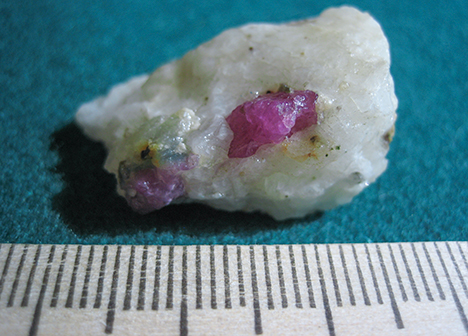
At the Snezhnoe deposit, bright red gem-quality ruby crystals with a slightly purple hue are found in marble (figure 8). These samples were characterized by a prismatic habit with c, r, and z faces, as well as irregular morphology with normally rounded faces (figure 9). Most of these samples were transparent and much shorter in length than the type found within micaceous lenses, often no longer than 8–10 mm. The ruby crystals were free of visible morphological defects except for occasional parting, typically parallel to the c and r crystal faces.
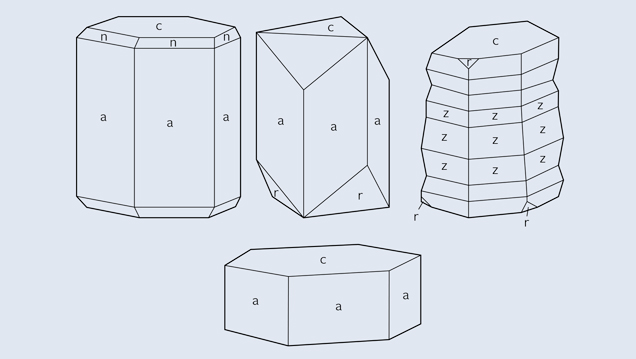
RESULTS AND DISCUSSION
Gemological Characteristics. The gemological properties of rubies and sapphires from the Snezhnoe deposit were similar to those previously observed by other researchers (Henn and Bank, 1990; Smith, 1998) and quite typical for corundum overall (table 1).
The results of this study showed a refractive index of no = 1.762–1.764 and ne = 1.772–1.774. Birefringence was 0.008–0.009. Specific gravity ranged from 3.99 to 4.01. Pleochroism was usually weak to medium for crystals from the micaceous lenses but strong in marble-hosted samples; dichroism was orange-red parallel to the c-axis and reddish violet perpendicular to the c-axis. The samples luminesced strong red under long-wave UV and weak red under short-wave UV.
Internal Growth Structure. Ruby and sapphire from micaceous lenses contained abundant defects. Purple and dark red specimens showed parting along the r and a faces, respectively. Pink sapphires exhibited polysynthetic twinning along the r face. Marble-hosted ruby did not show any visible defects, probably due to the recrystallization process, which may also explain their rounded faces.
Inclusions. Ruby and Sapphire from Micaceous Lenses. One of the most interesting findings of this study was that protogenetic inclusions of allanite were recognized in about 10% of the samples. Hexagonal allanite crystals with relicts of U-bearing thorianite and REE carbonates were also detected next to plagioclase and sapphire (Sorokina et al., 2012; figure 10). Inclusions and hexagonal crystals of allanite contained rare earth elements (table 2).
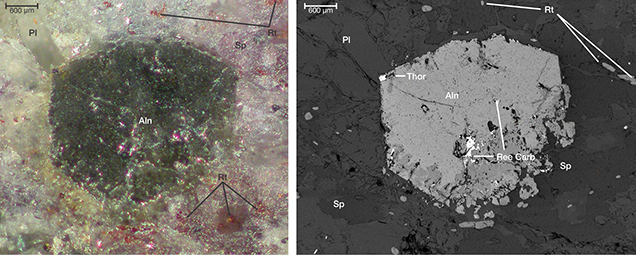
Another notable finding involved syngenetic particles and flakes of light blue mica (figure 11) with sizes varying from approximately 200 to 300 µm. Samples from Snezhnoe have previously been examined by X-ray powder diffraction, which identified diffraction lines close to margarite mica.
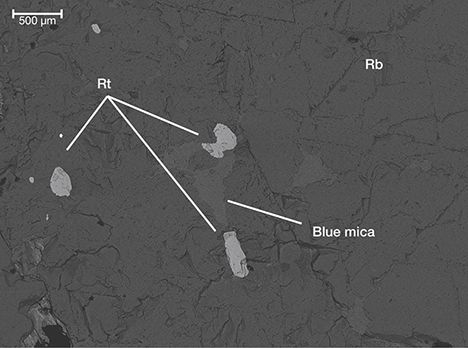
Using data from microprobe analyses, we found that the main mica cations were Ca and Na. The ratio of their ions was approximately 1:1. In a few samples, Na ions outnumbered Ca, reaching the ionic number of 0.59 in structural formula (table 3).
To identify the chemical elements that compensated the charge of the Na ions replacing Ca within the mica structure, we turned to LA-ICP-MS (table 4). These analyses showed an additional Li component, a finding that would have been impossible to determine by electron microprobe (see Schaller et al., 1967, and references therein). The maximum concentration of Li within mica is about 2020 ppm. Moreover, we detected Cr and Sr up to 2186 ppm and 1518 ppm, respectively. Therefore, the blue mineral inclusions are mica of the margarite-ephesite series—calcic ephesite or soda margarite, enriched with Cr and Sr.
We also observed rounded, transparent inclusions (probably protogenetic) that were previously identified as zircon (Smith, 1998). The zircon inclusions, ranging from approximately 50 to 70 µm in size, showed high relief and strong interference colors. HfO2, up to 2.05 wt.%, was detected in the composition of this solid inclusion (see again table 2).
High-relief particles of dark brown rutile were observed as syngenetic inclusions (previously detected by Henn and Bank, 1990), ranging from approximately 150 to 300 µm (figure 12). They showed twinning with an angle of about 115º. The rutile inclusions were normally enriched with Cr (up to 0.81 wt.%; table 2).
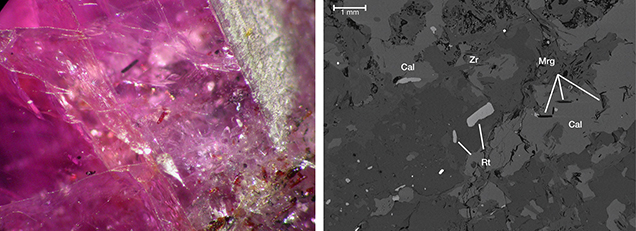
Similar to previous studies (e.g., Smith, 1998), we also detected the transparent irregular form of feldspar inclusions within ruby crystals. Two types of feldspar were detected: K-feldspar (microcline) and Ca-Na plagioclase (labradorite-anorthite). Most of the feldspar inclusions were twinned, measuring approximately 300 to 400 µm. Their birefringence was 0.006–0.007; relief was low, with crystals showing cleavages in two directions.
Ruby from Marbles. Flakes of fuchsite with Cr2O3 concentration above 1 wt.% (Deer et al., 1962) and intergrowths of green muscovite and fuchsite were detected within this type of ruby sample (figure 13 and table 2). The birefringence in thin sections ranged up to 0.027. Flakes of these mica inclusions were replaced in part by a green mineral of the chlorite group, probably prochlorite.
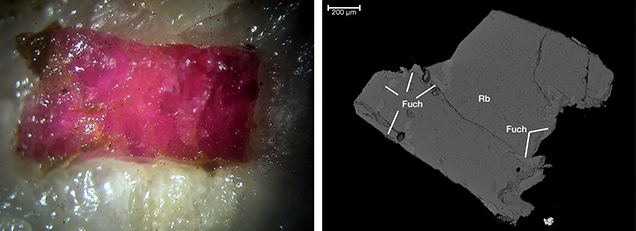
Smith (1998) previously identified other solid inclusions in rubies and sapphires from the Snezhnoe deposit, such as calcite and titanite. Although margarite is a common inclusion for gem corundum, the discovery of mica of the margarite-ephesite series (calcic ephesite or soda margarite) has not been reported in ruby, to the best of our knowledge (Gübelin and Koivula, 1986, and references therein; Hughes, 1997). Moreover, allanite is rarely detected in corundum (Hänni, 1990; Sutherland et al., 2008), and along with muscovite and fuchsite it has not been reported within ruby and sapphire from Snezhnoe until now. Therefore, these features can be used together with zircon, rutile, and feldspar inclusions to distinguish these gemstones from Tajikistan.
Chemical Composition. To study the composition of ruby and sapphire from Snezhnoe, we performed LA-ICP-MS analysis on 22 elements and electron microprobe analysis for Fe (table 5). The results showed that quantities of chromophores such as Ti, V, Cr, and Fe were within the normal range for ruby of similar formation type (table 6). The samples from micaceous lenses contained the following concentrations of trace elements: 416–2820 ppm Cr, 17.2–165 ppm Ti, 37–95 ppm V, and 52–87 ppm Ga. For marble-hosted ruby, the ranges were: 1696–4204 ppm Cr, 5.7–75 ppm Ti, 51–122 ppm V, and 60–83 ppm Ga. The highest Cr concentrations were observed in the bright red marble-hosted ruby. These values were close to those of other rubies of similar formation type, including samples from Mogok, Myanmar (analyzed by Muhlmeister et al., 1998; table 6).
Spectroscopy. Corundum from Snezhnoe ranges from purple (416–661 ppm Cr) to slightly pink (687–1775 ppm Cr) to dark red (2012–2820 ppm Cr). The range of ruby color includes the bright red with slightly purple hue known as “pigeon’s blood” (1696–4204 ppm Cr). Reflectance spectra were recorded from these four different types. The common features were wide bands at about 410 and 555 nm and a line at 694, related to Cr3+ transitions (Marfunin, 1974; figure 14). Thus, we concluded that the main chromophore for these samples is Cr3+. A higher chromium concentration enhances the depth of red color from slightly pink to dark red to bright red with a hint of purple. Another possible chromophore for the purple sapphires is V3+; note the concentration of vanadium in table 5. Difficulty in detecting the V3+ chromophore is caused by the low V3+ to Cr3+ ratio (table 5) and the superposition of their absorption bands (Schmetzer and Bank, 1981; Platonov et al., 1984).
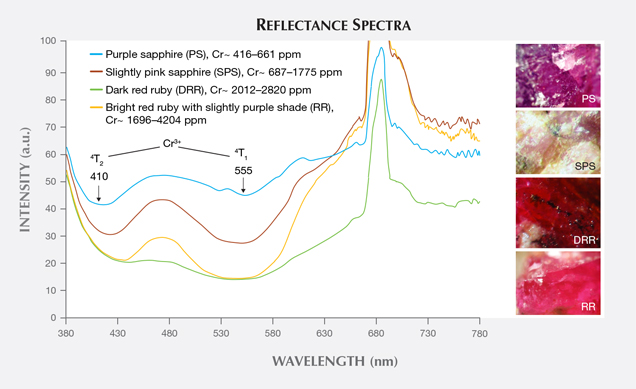
Luminescence spectra commonly show an R-line of single Cr3+ at 692 nm and a few N-lines of Cr3+ pairs at around the 699–710 nm (Taraschan, 1978; figure 15). The intensity of luminescence increased with Cr content in the samples. The highest intensity was observed in bright red ruby.
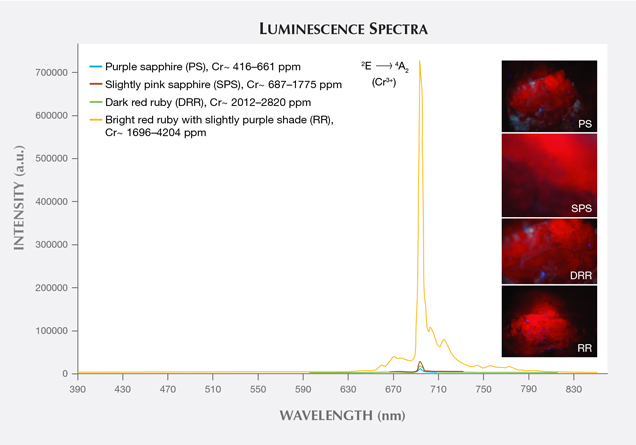
CONCLUSIONS
Located high in the Pamir Mountains of Tajikistan, the Snezhnoe deposit is a unique source of corundum, including various colors of pink to purple sapphire and “pigeon’s blood” ruby. Although its reserves of gem-quality corundum are estimated at many hundred thousand carats, the occurrence has seen only limited study. This article reviewed the geology of Snezhnoe and characterized the corundum from this source. We reported gemological features (RI, birefringence, density, pleochroism, dichroism, and photoluminescence) very similar to those previously published by Henn and Bank (1990) and Smith (1998). Cr3+ bands and lines were common features recorded in the luminescence and reflectance spectra for the ruby and sapphire. Previously undocumented solid inclusions of mica from the margarite-ephesite series were found in our samples. Inclusions such as allanite, muscovite, and fuchsite were discovered for the first time within corundum from Snezhnoe, to the best of our knowledge. These can be used along with other inclusions (zircon, rutile, K-feldspar, and Ca-Na-plagioclase) for possible origin identification of rubies and sapphires from Snezhnoe. LA-ICP-MS detected 22 trace elements, including the main chromophores (Cr, V, and Ti) and a common trace element in natural corundum (Ga). The concentration values were within acceptable range for isomorphic impurities in the mineral structure. The highest Cr concentrations were observed in the bright red marble-hosted ruby, which had a value close to those of similar genetic type, including the famous Burmese rubies from Mogok.
As we continue to learn more about marble-hosted ruby occurrences in Central Asia, further investigations remain necessary to better understand the genetic nature of the Snezhnoe deposit and the geological processes that took place there long ago.









